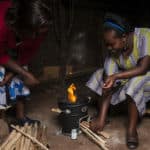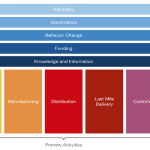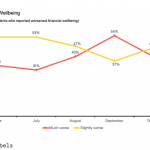To Stop Climate Catastrophe, Invest in Clean Cooking: Exploring the Lack of Funding – And Signs of Progress – In the Industry
As the past few years have shown, summer in the 21st century brings a new annual reality: devastating heat waves and wildfires. Throughout the summer of 2022, countries across Europe, North Africa and Asia saw record-breaking temperatures and fire damage, while in the United States, wildfires continue to threaten communities and fragile forests.
The effects of climate change have made summer synonymous with dangerous weather – and the threat is only beginning. It is increasingly clear that climate change is no longer a future risk we need to prepare for, but an urgent, ongoing crisis we need to navigate. To tackle this challenge head-on, we need to look at every tool we have available to reduce global greenhouse gas emissions.
And there’s one tool that can have an immense impact on our climate, though it rarely attracts the attention it deserves: cooking.
The Climate Impact of Underfunding Clean Cooking
In the West, we take for granted that we can cook with efficient, low-polluting energy sources like electricity and gas. But for 2.4 billion people around the world, primarily in Asia and sub-Saharan Africa, those clean, modern cooking options are simply not accessible. Instead, households depend on inefficient, carbon-emitting cooking methods: in particular, wood- and charcoal-burning fires.
Every year, cooking with solid fuels produces as much climate-harming emissions as the global airline industry, accounting for more than half of all human-generated emissions of black carbon, which is up to 1,500 times more impactful on global warming than CO2. Along with increasing greenhouse gas emissions, it reduces the planet’s ability to absorb them. In countries like the Democratic Republic of Congo, where 90% of the population relies on charcoal for cooking, over a million acres of primary rainforest were lost in 2020 alone to wood fuel collection, driving forest degradation and harming precious ecosystems that naturally remove carbon from the atmosphere.
Yet despite this enormous toll on climate and nature, not to mention on human health, clean cooking remains one of the most undervalued and underfunded climate solutions on the planet. The total investment needed to achieve universal access to clean cooking solutions by 2030 is around $8 billion per year. Yet current financing levels are far short of that: The 10 largest clean cooking companies have raised $200 million since 2014, 68% of total investments during this time. The World Bank estimates that the lack of progress on clean cooking costs the world more than $2.4 trillion each year, driven by adverse impacts on health, nature, climate and gender equality. So funding clean cooking would clearly deliver a worthwhile return on investment.
The Momentum Behind Clean Cooking Investments and Enterprises
The good news is that there’s growing momentum behind the global effort to address this issue. Nearly 70 countries have already included household energy or clean cooking-related goals as part of their climate plans through the Paris Agreement. Kenya, for example, has committed to planting 2 billion trees by 2022, restoring 5.1 million hectares of forests, and transitioning from biomass energy to 100% clean cooking fuel by 2028. Nepal will install 500,000 improved cookstoves in rural areas by 2025, and transition 25% of households to electric cooking by 2030. Rwanda’s climate action plan commits the country to reducing emissions by 38% by 2030, to be achieved through an ambitious clean energy agenda focused on reducing dependence on firewood for cooking.
But these transitions are only possible if we build a vibrant ecosystem to enable the growth of a clean cooking industry. We have the knowledge and technology to provide safe and affordable clean cooking to every person in the world—but only if governments, investors and the private sector make it a priority. We urgently need greater amounts of capital to flow into clean cooking, and we need that capital to come from a much wider pool of investors with varying appetites for risk and return.
This week’s Clean Cooking Forum 2022, taking place in Accra, Ghana – as well as the upcoming COP27 in Egypt – will serve as fitting platforms to deliver this critical message.
We’re already seeing encouraging signs of progress – and recent investment and business trends could represent a turning point. In recent months and years, several clean cooking enterprises have raised previously unheard-of levels of capital. In February, Sistema.bio closed $15.6 million in financing to scale their biogas offering. In June of 2021, XpressGas, the fastest-growing liquified petroleum gas company in Ghana, raised $6 million. Earlier that year, Israel-based HomeBiogas issued a successful $94 million IPO to bring its own biogas systems to new markets. The amount of capital raised by the clean cooking industry in the first part of 2022 is more than double what was reported in all of 2020.
In addition, several enterprises have seen significant customer growth, highlighting the potential to deliver pioneering technologies on a bigger scale. For instance, Bboxx received $5.5 million from the Africa Go Green Fund to roll out solar home systems and clean cooking solutions across Africa. And KOKO Networks is developing Rwanda’s first national renewable cooking fuel utility, leveraging $25 million in private climate finance.
We’re also seeing more businesses and collaborators from other industries develop partnerships and start new initiatives focused on clean cooking – including investors and funds that haven’t previously been engaged in the sector. The Spark + Africa Fund — the world’s first impact fund financing clean cooking solutions — has a target fund size of $70 million, and earlier this year it reached its first financial close with $40 million. This shows the appetite of a wide range of investors — including development finance institutions, private foundations and pension funds — for establishing and funding this emerging commercial industry.
These are exciting signs of real momentum, but we have a long way to go. We will never fully achieve our global climate and development goals without changing the way people cook, and doing that will require more and more of these kinds of investments and investors. Failure to invest in clean cooking puts millions of lives at risk, threatens to undermine billions of dollars in climate mitigation investments – and imperils the future of the planet we share. Failure is not an option. We must act now.
Dymphna van der Lans is the Chief Executive Officer of the Clean Cooking Alliance (CCA).
Photo courtesy of Ben Grey.
- Categories
- Energy, Environment



